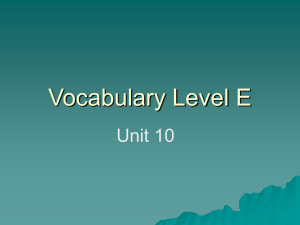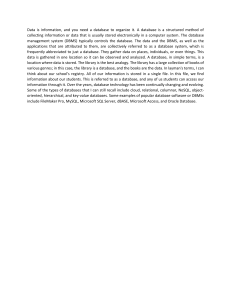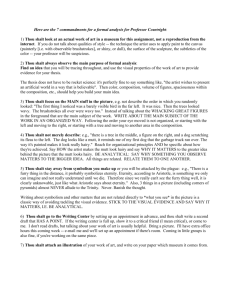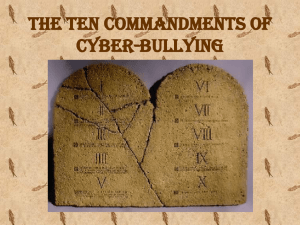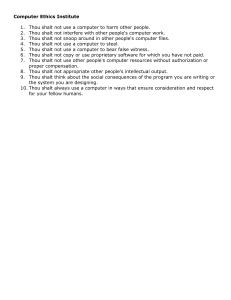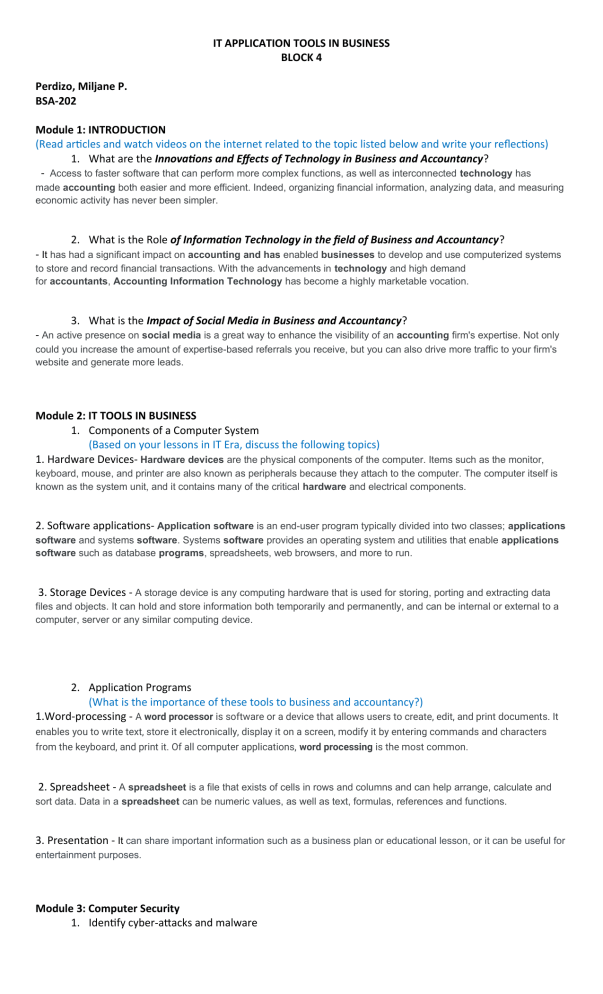
IT APPLICATION TOOLS IN BUSINESS BLOCK 4 Perdizo, Miljane P. BSA-202 Module 1: INTRODUCTION (Read articles and watch videos on the internet related to the topic listed below and write your reflections) 1. What are the Innovations and Effects of Technology in Business and Accountancy? - Access to faster software that can perform more complex functions, as well as interconnected technology has made accounting both easier and more efficient. Indeed, organizing financial information, analyzing data, and measuring economic activity has never been simpler. 2. What is the Role of Information Technology in the field of Business and Accountancy? - It has had a significant impact on accounting and has enabled businesses to develop and use computerized systems to store and record financial transactions. With the advancements in technology and high demand for accountants, Accounting Information Technology has become a highly marketable vocation. 3. What is the Impact of Social Media in Business and Accountancy? - An active presence on social media is a great way to enhance the visibility of an accounting firm's expertise. Not only could you increase the amount of expertise-based referrals you receive, but you can also drive more traffic to your firm's website and generate more leads. Module 2: IT TOOLS IN BUSINESS 1. Components of a Computer System (Based on your lessons in IT Era, discuss the following topics) 1. Hardware Devices- Hardware devices are the physical components of the computer. Items such as the monitor, keyboard, mouse, and printer are also known as peripherals because they attach to the computer. The computer itself is known as the system unit, and it contains many of the critical hardware and electrical components. 2. Software applications- Application software is an end-user program typically divided into two classes; applications software and systems software. Systems software provides an operating system and utilities that enable applications software such as database programs, spreadsheets, web browsers, and more to run. 3. Storage Devices - A storage device is any computing hardware that is used for storing, porting and extracting data files and objects. It can hold and store information both temporarily and permanently, and can be internal or external to a computer, server or any similar computing device. 2. Application Programs (What is the importance of these tools to business and accountancy?) 1.Word-processing - A word processor is software or a device that allows users to create, edit, and print documents. It enables you to write text, store it electronically, display it on a screen, modify it by entering commands and characters from the keyboard, and print it. Of all computer applications, word processing is the most common. 2. Spreadsheet - A spreadsheet is a file that exists of cells in rows and columns and can help arrange, calculate and sort data. Data in a spreadsheet can be numeric values, as well as text, formulas, references and functions. 3. Presentation - It can share important information such as a business plan or educational lesson, or it can be useful for entertainment purposes. Module 3: Computer Security 1. Identify cyber-attacks and malware - Cyberattacks- If your firm is attacked, knowing what’s happened can help limit damage and restore your systems quickly. This guide explains how to recognise and prevent the different threats. The most common cybercrimes are phishing and vishing scams. They rely on people being tricked into sharing secure information. Law firms are a common target for a type of phishing attack known as “Friday afternoon fraud”. Data breaches must be reported to the Information Commissioner's Office within 72 hours of being discovered. Everyone in your firm should know how to do this. Supply chain attacks target less secure parts of your supply network. You should know how to monitor your suppliers and manage the risk. - Malware - ‘Malicious software’, known as malware, is designed to cause damage to computer systems. Ransomware, spyware and viruses are examples of malware. 2. Distinguish differences on cyber intruders: Trolls - It is someone who deliberately starts a fight and insults others in online forums. They disrupt discussions in an effort to cause drama. They are practically omnipresent on social media. Spies - Cyber espionage is a form of cyber attack that steals classified, sensitive data or intellectual property to gain an advantage over a competitive company or government entity. Hackers - The hacker is someone who is mastermind in art of programming to point that he or she simply sit down and hack in a program that works. But the intruders are basically who violate networks and information systems. Thieves - Thieves are creating other types of Trojans that steal account information and key files of various program products and resources from infected computers, for the benefit of the thief. 3. Discuss security issues and threats to computers and communication - There are many threats to computer and the communication system which are error, accident and natural hazards. 1: Human Errors Humans often are not good at assessing their own information Humans emotions effect their performance Humans perceptions are slower compared to the equipment information overload to humans can sometimes be a problem 2: Procedural Errors When people fail to follow the steps and instruction prepared, error tends to occur 3: Software Errors Software malware or bug : causes a program or software to not run properly 4: Dirty Data problems incomplete, outdated or inaccurate source of data 5: Electromechanical problems Mechanical system can wear out or become damaged after a period of usage They can sometimes be badly designed or constructed Power surges and failures can damage the equipment connected 6: Natural hazards Unpredictable and often lead to disaster when occurs 7: Computer Crimes Computer crimes can be categorized into two which is illegal act perpetrated against computer or telecommunications and use of computer and telecommunications to accomplish illegal acts by using the computer as a tool Other examples of computer crimes are theft of hardware, theft of software, theft of intellectual properties, theft of time and services, theft of information and many more 4. Distinguish security safeguards protecting computers and communications - Security is a system or software of safeguard for protecting information technology against facing disaster, system failures, and also unauthorized access that can result in damage and lost. Computer security can be divided into five components: 1: Deterrents to computer crime Enforcing the law CERT to provide round the clock information on international computer security threats Tools used to fight fraudulent and unauthorized online uses Rule base detection software predictive statistical model software Employee internet management Internet browsing filtering software Electronic surveillance 2: Identification and access Verify legitimate right of access by what you have, what you know, and who you are What you have like keys, cards, signatures, badges What you know like pin numbers and passwords Who are you like bio metrics such as face scan and finger print scan 3: Encryption The process of altering and changing a data into unreadable form to prevent unauthorized access Advantage is data is available over the internet Disadvantage is law officer may not be able to read the data. 4: Protection of software and data Restrict access to online files; use transaction logs Use audit controls to track who used what programs and servers, which files were opened, and so on Use people controls—screen applicants; do background checks; monitor Internet, email, and computer usage; use shredders for discarded documents and materials 5: Disaster Recovery Plan Method of retrieving important data and information after a disaster has happened Data storage system must be kept separately and data have to be backed up Back up all data and keep in mainframes in different positions 5. Explain privacy surveillance: data collectors - Data Modelers and Data Governance experts need to work with the company’s security experts to create policies and procedures designed to handle confidential data within the organization and to decide which data can be safely exposed to vendors and others outside the firm. spies - Spying combines monitoring and surveillance with active intelligence gathering and data analysis to discover what is occurring relative to government or corporate interests. Spying can be used in the interest of national security, by unscrupulous corporations to discover trade secrets, or has the media discovered, to sway individual’s opinions about political candidates, high-profile individuals, or national interests. 6. What are the computer crimes and cybercrime law - Computer crime describes a very broad category of offenses. Some of them are the same as non-computer offenses, such as larceny or fraud, except that a computer or the Internet is used in the commission of the crime. Others, like hacking, are uniquely related to computers. Read on to find out what kinds of activities are considered computer crimes and how to protect yourself from them. - cybercrime law Computer Crime Cyberbullying Sexting Identity Theft 7. The Ten Commandments of Computer Ethics 1. 2. 3. 4. 5. 6. 7. 8. 9. Thou shalt not use a computer to harm other people. Thou shalt not interfere with other people's computer work. Thou shalt not snoop around in other people's computer files. Thou shalt not use a computer to steal. Thou shalt not use a computer to bear false witness. Thou shalt not copy or use proprietary software for which you have not paid (without permission). Thou shalt not use other people's computer resources without authorization or proper compensation. Thou shalt not appropriate other people's intellectual output. Thou shalt think about the social consequences of the program you are writing or the system you are designing. 10. Thou shalt always use a computer in ways that ensure consideration and respect for other humans Module 4: Introduction to Database Management 1. Describe the enrollment process of SPUS based on your experiences during enrollment. Identify the advantages/ disadvantages and benefits of having a computerized enrollment system - In what I’ve experienced during enrollment is that it is more easy for then to encode but it’s still depends to the wifi connection. And it’s still need staff in the finance and registrar because even it is computerised system still need enough staff to work on the computer. There are lots of students in Spus, but the flow in the enrollment is so slow because lack of staff. Advantage Computerized systems allow for greater efficiency in performing specific tasks both more accurately and more rapidly than doing the same task using, for example, a pencil and paper or a pencil and ledger book. Computerized systems also offer storage capacity efficiency. For example, a computerized system's hard drive taking up a relatively small amount of space can store a large collection of business or personal documents. A paper-based system, in contrast, would take up at least one, and usually more, file cabinets for storage of the same document collection. Disadvantages: Miscellaneous Rapid changes in technology can cause a computer to become outdated relatively quickly, requiring upgrades or replacements on a regular basis for computerized systems deployed in business use. Computerized systems can also give some users a sense of false security that can result in catastrophic losses of massive amounts of present or past work unless the user learns to use proper backup procedures. Computer work also has been implicated in a variety of health-related issues, such as skeletal problems, eyestrain and a complex of conditions known as repetitive stress injury with carpal tunnel syndrome illustrating the best-known repetitive-stress condition. 2. Describe the computerized process used in the Library. - It is way better for example attendance to the students who enter in the library, you don’t need to write your name on the paper instead swipe your ID and it detected. With the help of library system we can maintain the stocks such as books,newspapers, magazines more efficiently. With the help of this feature our manual works have reduced to a great extent. This feature also helps in editing or deleting the data, if required. 3. What is Database? - A database is a collection of information that is organized so that it can be easily accessed, managed and updated. Computer databases typically contain aggregations of data records or files, containing information about sales transactions or interactions with specific customers. Database Management System?- It is a software package designed to define, manipulate, retrieve and manage data in a database. A DBMS generally manipulates the data itself, the data format, field names, record structure and file structure. It also defines rules to validate and manipulate this data. 4. What are the advantages and disadvantages of a database? Advantages of Database 1) Data Abstraction: Data abstraction means, to hide the complexity of data from the basic users. DBMS abstracts the data to the users, which is not useful for the users. It shows only those data which are useful to the users. 2) Controlling Data Redundancy: Data redundancy means having multiple copies of the same data. DBMS controls the data redundancy and integrates all data into a single database file. 3) Minimized Data inconsistency: Data inconsistency means that different files may contain different information of a particular object or person If DBMS has reduced the data redundancy than the database system leads the better data consistency 4) Data Manipulation Easily: In DBMS, Data can be manipulated easily, because data is centralized so once the data structure is defined, we can easily change in the data like- insertion, modification or deletion. 5) Data can be shared: Data can be shared easily by multiple applications in centralized DBMS. The applications can be developed without having to create any new stored files. 6) Data Security: Database provides data security means protecting your precious data from unauthorized access. Data can be access only by authorized users of the organization. A database can be accessed only by proper authentication usually by verifying login and password. 7) Support Multi-users Views: Multi-users can view the data at the same time. 8) Concurrent Access: Several users can access the database concurrently. Disadvantages of Database 1) Cost of Hardware and Software: To run the DBMS software, we need a high-speed processor and large memory size is required which cause expensive hardware is needed. 2) Cost of Data Conversion: When a computer file-based system is replaced with a database system, then the data stored in data files must be converted into database files. It is the difficult and time-consuming method to convert the data of data files into database 3) Cost of Staff Training: DBMS are often complex system, so the training is required for the users to use the DBMS. The organization has to be paid plenty of amount for the training of workers to run the database management system. 5. Give examples of database management application. - MySQL, PostgreSQL, Microsoft Access, SQL Server, FileMaker, Oracle, RDBMS, dBASE, Clipper, and FoxPro. Since there are so many database management systems available, it is important for there to be a way for them to communicate with each other. General REFLECTION Information technology drives innovation and innovation is the path to business success. Innovation in business has the same impact that steam had on the industrial revolution. Nowadays the formula for business success is simple: drive innovation with information technology. So, the first thing startups in any industry try to figure out is how to make smart IT recruiting choices. Without a backbone of information technology, a business is not going to go far. It actually relies on creativity and problem-solving. This field provides you with the unique opportunity to use your tech skills to come up with innovative solutions to problems faced by your clients, company and the population as a whole. You have the opportunity to use your skills to make major contributions. Using application tools in business helps me become more engaged, it teaches to the students not only me to enjoy and embrace the learning process, even if they don’t realize it. As a student seeks out new information and answers to questions, they develop a habit of exploratory learning. This is the foundation of career learning. It continually seek new information and ways to better themselves, ultimately leading to skills they can put to use in their personal and professional lives. Additional Assignment: Reflection Journal (per module) 1. What have I learned that helped me do all aspects of this better? 2. What have I done that has made me better at doing all aspects of this? 3. How can I improve at doing all aspects of this? Note: Send your outputs through email Faculty – Mrs. Karen T. Plaza, MSIT Email address: iamkayplaza2@gmail.com Contact number: 09989512749 For those who don’t have internet connection please feel free to text/call me and we will discuss how you can comply with the requirements… Activities for Modules 5 to 8 will be sent soon , please be guided… As to the deadline we will just agree on that matter some other time. Thank you and keep safe everyone… JOURNAL 2 A database management system makes it possible for multiple authorized users to access the same database from different places, in different ways, to fulfill different intents. Databases give you lots of different ways to look at your data. A request for a specific answer or list from your database called a "query" can take just a minute or two to write, as opposed to hand-collating data records or sorting and resorting a spreadsheet. Plus, you can write standing queries to answer the questions you ask frequently, so an up-to-the-minute answer is just seconds away. The major advantages of a database system approach to managing data include improving data sharing for users, improving data security, improving data access and improving data integration while minimizing data inconsistencies. This will lead to improved decision making and productivity. Microsoft access is a Database Management System offered by Microsoft. It uses the Microsoft Jet Database Engine and comes as a part of the Microsoft Office suite of application. Microsoft Access offers the functionality of a database and the programming capabilities to create easy to navigate screens (forms). It helps you analyze large amounts of information, and manage data efficiently. I believe this is an area where we may see some change in the not-so-distant future. IT started by creating systems so that people could store data in disks rather than on paper. Those applications were program-heavy while the data was in electronic files. Systems now can store data in much more complex and efficient ways. Relationships between data entities can exist, we can access data that is not contained within our systems and businesses are demanding more intelligence out of their data. Also, for some industries, current data entry methods which may currently include a person entering data will be replaced by machines. This may diminish the need for programming, and the sheer volume and variety of data being collected may stimulate some IT professionals to pursue a career in data management.


